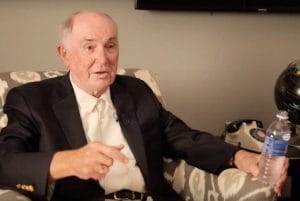An entrepreneur, in 1966 Blay co-founded Stereodyne, a company to duplicate 8-track tapes, and then cassettes, for the booming home and car stereo market. In 1969, he started Magnetic Video Corporation to capitalize on the corporate use of reel-to-reel video tapes, duplicating those, too. As he looked for ways to expand that business, he learned that Hollywood studios were selling 20-minute excerpts of popular movies on 8mm film reels. “If they can make $40 million doing that,” he thought, “we can make a hell of a lot more selling the full version” — especially as video cassette recorders were starting to make their way into homes. Even though it was a bleak financial time for Hollywood studios, they resisted the very idea. “The VCR is to the American film producer and the American public as the Boston strangler is to the woman home alone,” said the president of the Motion Picture Association of America, Jack Valenti. Still, in 1977 one of the most in-trouble studios, 20th Century Fox, accepted Blay’s offer.

It was a big risk for Blay: for the right to sell videos of Fox’s 50 top movies, he agreed to pay the studio $300,000 up front (equivalent to about $1.3 million today), plus $500,000 per year, plus $7.50 for each film sold. But Blay’s timing was excellent: despite their high cost, VCRs were exploding into the consumer market, which drove a desire for good content to play on them. To stoke demand, Blay created the Video Club of America, advertising memberships in TV Guide and charging a fee to join, and then selling movies at “discount” — just $50 each! Its cassettes, of course, were duplicated by Magnetic Video. The high price of the movies on cassette led to a strong rental market, and video rental stores popped up, creating more and more demand for movies, and of course more VCRs. That proliferation drove down the cost of VCRs (and the movies), creating more and more demand — a feedback loop. Blay made millions — and in 1979 Fox bought out his Magnetic Video operation for $7.2 million (about $27 million equivalent today) to create 20th Century Fox Video — and hired Blay as CEO. By 1985 a quarter of American homes had VCRs, and by 1987 Hollywood studios were making more income from video sales than they were from movie theaters, lifting them out of their economic doldrums and sparking a renaissance in the movie industry, leading to a huge upswing in independent films — some “direct to video” — to supply the ever-increasing demand.

In 2012, the Museum of Art and Design in New York said the demand for home video “fostered the expansion of cinema into new aspects of daily life, resulting in an explosion of new cinematic genres and techniques, the video store, and an impressive increase in audiences.” Blay was inducted into the Consumer Electronics Association Hall of Fame for having “sparked a retail revolution as hundreds of mom-and-pop video and rental sales stores popped up in every community in America.” Blay went on to become CEO of Embassy Home Entertainment, where he oversaw the production of independent films, including 1987’s Princess Bride, and later started his own independent film company. He retired a multi-millionaire, and wrote his memoir, Prerecorded History, detailing the rise of home video from his point of view. Blay died from pneumonia on August 24, at 81.
Author’s Note: While Andre didn’t die in the last week or so (which is my preferred rule for the Honor), news of his death didn’t hit the industry press right away — one of the hazards of my wanting to honor “the forgotten people who had an impact on our lives.” Since that impact was so profound, I chose him for this week anyway.
